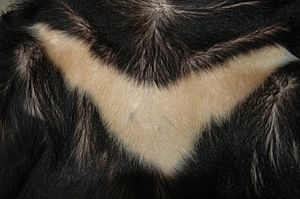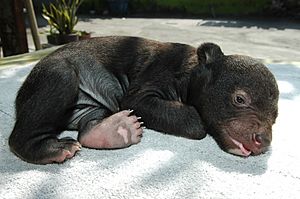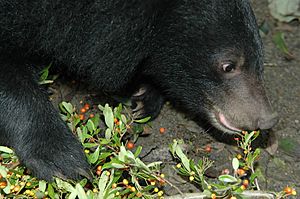Asian black bear facts for kids
Quick facts for kids Asian black bear |
|
|---|---|
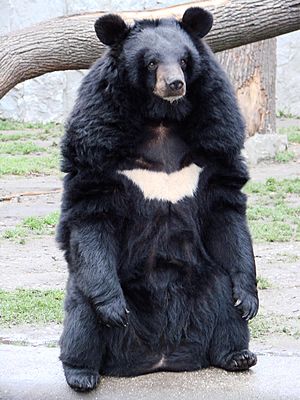 |
|
| Conservation status | |
| Scientific classification | |
| Genus: |
Ursus
|
| Species: |
thibetanus
|
| Subspecies | |
|
7, see text |
|
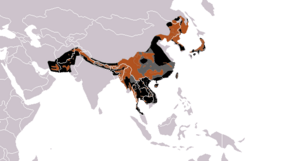 |
|
| Asian black bear range (brown – extant, black – extinct, dark grey – presence uncertain) |
|
| Synonyms | |
|
Selenarctos thibetanus |
|
The Asian black bear (Ursus thibetanus or Selenarctos thibetanus) is a medium-sized, sharp-clawed, black-colored bear with a distinctive white or cream "V" marking on its chest. It is also known as the Asiatic black bear, Tibetan black bear, the Himalayan black bear, or the Moon bear.
It is a close relative of the American black bear with which it is thought to share a European common ancestor. It is called 반달가슴곰 (bandalgaseumgom) in Korean. Both American and Asiatic species are thought of as sister taxa. They are more closely related to one another than any other species of bear.
Contents
Characteristics
Asiatic black bears are black and have a light brown muzzle. They are white on the chin, and have a distinct white patch on the chest, which sometimes has the shape of a V. Their ears are bell shaped, proportionately longer than those of other bears, and stick out sideways from the head. The tail is 11 cm (4.3 in) long. Adults measure 70–100 cm (28–39 in) at the shoulder, and 120–190 cm (47–75 in) in length. Adult males weigh 60–200 kg (130–440 lb) with an average weight of about 135 kg (298 lb). Adult females weigh 40–125 kg (88–276 lb), and large ones up to 140 kg (310 lb).
Asiatic black bears are similar in general appearance to brown bears, but are more lightly built and are more slender limbed. The lips and nose are larger and more mobile than those of brown bears. The skulls of Asiatic black bears are relatively small, but massive, particularly in the lower jaw. Adult males have skulls measuring 311.7 to 328 mm (12.27 to 12.91 in) in length and 199.5–228 mm (7.85–8.98 in) in width, while female skulls are 291.6–315 mm (11.48–12.40 in) long and 163–173 mm (6.4–6.8 in) wide. Compared to other bears of the genus Ursus, the projections of the skull are weakly developed; the sagittal crest is low and short, even in old specimens, and does not exceed more than 19–20% of the total length of the skull, unlike in brown bears, which have sagittal crests comprising up to 41% of the skull's length.
Although mostly herbivorous, the jaw structure of Asiatic black bears is not as specialized for plant eating as that of pandas: Asian black bears have much narrower zygomatic arches, and the weight ratio of the two pterygoid muscles is also much smaller in Asian black bears. The lateral slips of the temporal muscles are thicker and stronger in black bears.
A black bear with broken hind legs can still climb effectively. In contrast to polar bears, Asiatic black bears have powerful upper bodies for climbing trees, and relatively weak hind legs which are shorter than those in brown bears and American black bears. They are the most bipedal of all bears, and have been known to walk upright for over a quarter mile. The heel pads on the forefeet are larger than those of most other bear species. Their claws, which are primarily used for climbing and digging, are slightly longer on the fore foot (30–45 mm) than the back (18–36 mm), and are larger and more hooked than those of the American black bear.
On average, adult Asiatic black bears are slightly smaller than American black bears, though large males can exceed the size of several other bear species.
The famed British sportsman known as the "Old Shekarry" wrote of how a black bear he shot in India probably weighed no less than 363 kg (800 lb) based on how many people it took to lift its body. The largest Asiatic black bear on record allegedly weighed 200 kg (440 lb). Zoo-kept specimens can weigh up to 225 kg (496 lb). Although their senses are more acute than those of brown bears, their eyesight is poor, and their hearing range is moderate, the upper limit being 30 kHz.
Behaviour
Asiatic black bears are diurnal, though they become nocturnal near human habitations. They may live in family groups consisting of two adults and two successive litters of young. They will walk in a procession of largest to smallest. They are good climbers of rocks and trees, and will climb to feed, rest, sun, elude enemies and hibernate. Some older bears may become too heavy to climb. Half of their life is spent in trees and they are one of the largest arboreal mammals. In the Ussuri territory, black bears can spend up to 15% of their time in trees. Asiatic black bears break branches and twigs to place under themselves when feeding on trees, thus causing many trees in their home ranges to have nest-like structures on their tops. Asiatic black bears will rest for short periods in nests on trees standing fifteen feet or higher. Asiatic black bears do not hibernate over most of their range. They may hibernate in their colder, northern ranges, though some bears will simply move to lower elevations. Nearly all pregnant sows hibernate. Black bears prepare their dens for hibernation in mid-October, and will sleep from November until March. Their dens can either be dug out hollow trees (sixty feet above ground), caves or holes in the ground, hollow logs, or steep, mountainous and sunny slopes. They may also den in abandoned brown bear dens. Asiatic black bears tend to den at lower elevations and on less steep slopes than brown bears. Female black bears emerge from dens later than do males, and female black bears with cubs emerge later than barren females. Asiatic black bears tend to be less mobile than brown bears. With sufficient food, Asian black bears can remain in an area of roughly 1–2 sq km, and sometimes even as little as 0.5–1 sq km.
Asiatic black bears have a wide range of vocalizations, including grunts, whines, roars, slurping sounds (sometimes made when feeding) and "an appalling row" when wounded, alarmed or angry. They emit loud hisses when issuing warnings or threats, and scream when fighting. When approaching other bears, they produce "tut tut" sounds, thought to be produced by bears snapping their tongue against the roof of their mouth. When courting, they emit clucking sounds.
Reproduction and life cycle
Within Sikhote-Alin, the breeding season of black bears occurs earlier than in brown bears, starting from mid June to mid August. Birth also occurs earlier, in mid January. By October, the uterine horns of pregnant females grow to 15–22 mm. By late December, the embryos weigh 75 grams. Sows generally have their first litter at the age of three years. Pregnant females generally make up 14% of populations. Similar to brown bears, Asiatic black bears have delayed implantation. Sows usually give birth in caves or hollow trees in winter or early spring after a gestation period of 200–240 days. Cubs weigh 13 ounces at birth, and will begin walking at four days of age, and open their eyes three days later. The skulls of newborn black bear cubs bear great resemblance to those of adult sun bears. Litters can consist of 1–4 cubs, with 2 being the average. Cubs have a slow growth rate, reaching only 2.5 kg by May. Black bear cubs will nurse for 104–130 weeks, and become independent at 24–36 months. There is usually a 2–3 year interval period before females produce subsequent litters. The average lifespan in the wild is 25 years, while the oldest Asian black bear in captivity died at the age of 44.
Feeding
Asiatic black bears are omnivorous, and will feed on insects, beetle larvae, invertebrates, termites, grubs, carrion, bees, eggs, garbage, mushrooms, grasses, fruits, nuts, seeds, honey, herbs, acorns, cherries, dogwood, and grain. Though herbivorous to a greater degree than brown bears, and more carnivorous than American black bears, Asiatic black bears are not as specialized in their diet as pandas are: while pandas depend on a constant supply of low calorie, yet abundant foodstuffs, black bears are more opportunistic and have opted for a nutritional boom-or-bust economy. They thus gorge themselves on a variety of seasonal high calorie foods, storing the excess calories as fat, and then hibernate during times of scarcity. Black bears will eat pine nuts and acorns of the previous year in the April–May period. In times of scarcity, they enter river valleys to gain access to hazelnuts and insect larvae in rotting logs. From mid-May through late June, they will supplement their diet with green vegetation and fruit. Through July to September, they will climb trees to eat bird cherries, pine cones, vines and grapes. On rare occasions they will eat dead fish during the spawning season, though this constitutes a much lesser portion of their diet than in brown bears. In the 1970s, black bears were reported to kill and eat Hanuman langurs in Nepal. They appear to be more carnivorous than most other bears, including American black bears, and will kill ungulates with some regularity, including domestic livestock. Wild ungulate prey can include muntjacs, serow, takin, wild boar and adult water buffaloes, which they kill by breaking their necks.
Interspecific predatory relationships
Asiatic black bears may be occasionally attacked by tigers and brown bears, although leopards, and packs of wolves and dholes can also be threats. Eurasian lynxes are a potential predator of cubs. Black bears usually dominate Amur leopards in physical confrontations in heavily vegetated areas, while leopards are uppermost in open areas, though the outcome of such encounters is largely dependent on the size of the individual animals. Leopards have been known to prey on cubs younger than two years old.
The Asiatic black bear's range overlaps with that of sloth bears in central and southern India, sun bears in Southeast Asia and brown bears in the southern part of the Russian Far East. Ussuri brown bears may attack black bears, though Himalayan brown bears seem to be intimidated by the black species in direct encounters. They will eat the fruit dropped by black bears from trees, as they themselves are too large and cumbersome to climb.
Tigers will occasionally prey on black bears. Russian hunters may occasionally find black bear carcasses showing evidence of tiger predation, and their remains may occur in tiger scats. If they manage to escape a tiger, black bears will attempt to rush up a tree and wait for the tiger to leave, though some tigers will pretend to leave, and wait for the bear to descend. One Manchurian tiger was reported to have lured an Asiatic black bear by imitating the species' mating call. Tigers regularly prey on young bears but adult bears are occasionally taken as well. Black bears are usually safe from tiger attacks once they reach five years of age. Although black bears prefer to avoid tigers, they can be extremely tenacious when attacked: Jim Corbett observed a fight between a tiger and the largest black bear he had ever seen, which resulted in the bear managing to chase off the tiger, despite having half its nose and scalp torn off. However, black bears may be less vulnerable than brown bears to tiger predation, due to their habit of living in hollows or in close set rocks, thus making them harder to pursue. At least one fatal attack on a juvenile bear has been recorded in Jigme Dorji National Park, as Bhutan's tiger populations have begun to colonise higher altitude areas. Black bears may steal tiger kills: Jim Corbett twice saw black bears carry off tiger kills when the latter was absent.
Distribution and habitat
Black bears typically inhabit deciduous forests, deserts, mixed forests and thornbrush forests. They rarely live in elevations of more than 12,000 feet (3,700 m). They usually inhabit elevations around 11,480 feet (3,500 m) in the Himalayas in the summer, and will climb down to 4,920 feet (1,500 m) in winter. They sometimes occur at sea level in Japan.
The fossil record indicates that black bears once ranged as far west as Germany and France, though the species now occurs very patchily throughout its former range, which is now limited to the Asian continent. Black bears occupy a narrow band from southeastern Iran eastward through Afghanistan and Pakistan, across the foothills of the Himalayas in India, to Myanmar. With the exception of Malaysia, black bears occur in all countries in mainland Southeast Asia. They are absent from much of east-central China, though they have a patchy distribution in the southern and northeastern part of the country. Other population clusters exist in the southern Russian Far East and into North Korea. South Korea has a small remnant population. Black bears also occur in Japan's islands of Honshu and Shikoku and on Taiwan and Hainan.
There is no definitive estimate as to the number of Asiatic black bears: Japan posed estimates of 8–14,000 bears living on Honshū, though the reliability of this is now doubted. Although their reliability is unclear, rangewide estimates of 5–6,000 bears have been presented by Russian biologists. In 2012, Japanese Ministry of the Environment estimated the population at 15–20,000. Rough density estimates without corroborating methodology or data have been made in India and Pakistan, resulting in the estimates of 7–9,000 in India and 1,000 in Pakistan. Unsubstantiated estimates from China give varying estimates between 15–46,000, with a government estimate of 28,000.
Images for kids
-
Kintoki Wrestling with a Black Bear, woodblock print by Torii Kiyomasu I, c. 1700, Honolulu Academy of Arts
-
A trio of captive Asian black bears around their keeper in Florence
-
An Asian black bear hunt, as illustrated by Samuel Howitt
See also
 In Spanish: Ursus thibetanus para niños
In Spanish: Ursus thibetanus para niños



